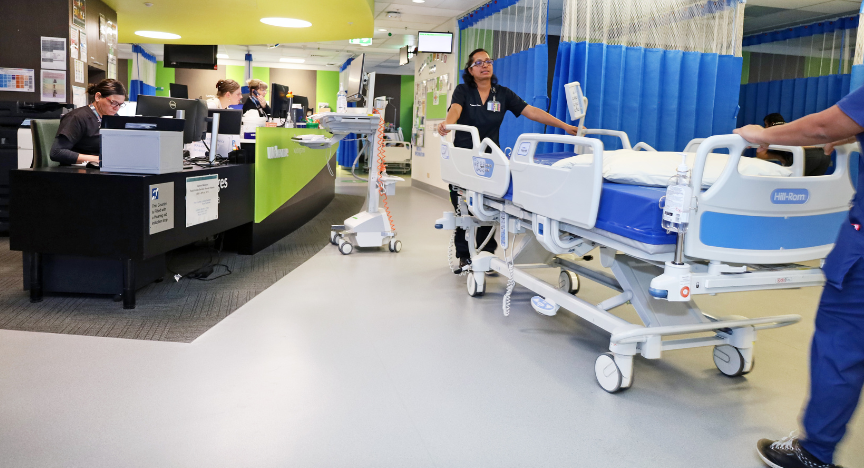
A new Intensive Flow Project is critically appraising the full picture of patient flow initiatives to maximise the benefits of each, add new models, update those that have changed, and improve the efficiency of how each contributes to the flow of patients receiving care across PA Hospital.
ADON Patient Flow, Nicola Ross (Nikki) said with increases in demand here to stay, and the addition of new beds from the PA Expansion Project years away, every available avenue for patient flow needs to be explored and tailored to deliver solutions right now.
“Individual models have been introduced over time to address known pressure points in the patient journey, each with their own benefits and challenges to the big picture.
“What this project is doing is bringing everything together to reinforce processes and solutions, tailor change, identify escalations, maximise additional beds, and ultimately add capacity wherever possible to manage community demand,” Nikki said.
What we need to solve:
Patient Flow is a complex equation considering PAH is a tertiary facility that offers the highest level of specialist care as well as elective and emergency care. With community demand for emergency care escalating, a key target of the project is to address increased length of stay in Emergency and associated ambulance ramping using every initiative available.
“This is a whole of system challenge looking at all stages of patient flow.
“We need to confidently address the problem of the right patients being in the correct bed for their needs – which patients need tertiary level support, are they in the right location within the hospital, and which patients are best treated in an alternative hospital or home with appropriate services that are better suited to their ongoing care,” Nikki said.
“There is opportunity to transfer patients back to their home hospitals after tertiary level care has been delivered if ongoing acute care is required. This will enable care closer to home and ensure there is capacity to provide tertiary and specialist care that needs to occur at PAH.
“Solving barriers to back transfers to home hospitals and patients out-of-catchment is a key focus.”
What we are doing:
By looking at each of the initiatives, new or reinforced directions can be crafted to maximise the benefits and remove the hiccups that interrupt efficiency.
“To do this, we are reviewing and realigning existing models of care alongside the technology we have to tighten up processes alongside the additional pathways now available,” Nikki said.
“For example, the Interim Admission Centre (IAC) has changed. IAC Previously opened at 230pm on a Sunday and closed at 11pm on Friday but current demand has meant that the beds can’t be decanted for the weekend. New funding has staffed the unit to operate 24/7 with processes in place to ensure this remains a transition space for patients waiting for their inpatient bed to be available.”
Current model improvements include:
- IAC – Staffed 24/7 as an escalation model to move patients being admitted from ED
- Bed Egress Coordinators are identifying all the discharge opportunities including aged care returns, home hospital returns, and alternative admission options such as Greenslopes.
- Additional beds are contracted at Greenslopes using additional pathways including a 24-hour admission window for overnight admissions. These additional beds and the overnight options reduce transfers from occurring overnight.
- Improved pathways with Hospital in the Home, Acute Care @ Home, CHIP, CAREPACT, rovers, Transit Care Hub, IAC and Rapid Access Services.
- Divisional accountability for escalation and de-escalation based on the bed platform and predicted discharges.
“We can see on Capplan and MSH Flow dashboard when predicted discharges aren’t matching the reality. But the prediction doesn’t necessarily result in embedded escalation processes which catches up with us as the week progresses,” Nikki said.
“This project will help to ensure patients have timely access to tertiary level care when they need it.
“Between the technology and the work of the many teams wrangling the daily bed puzzle, we hope that prediction in capacity and access demands will ensure early escalation across the divisions. This will allow earlier implementation of actions that will reduce the impact on flow in a timely manner.“
While the project is interrogating the current and new models available for patient flow, it is not making everything old, new again.
Nikki said the project is improving understanding about the journey of each patient and opportunities to transfer using available alternatives. Having clear visibility of all the opportunities highlights options that are more suitable to get the patient the care they need.
“It is about creating capacity in the system, and alternative pathways,” Nikki said.
“At the end of the day, the project is to improve and increase capacity within PAH. If we can improve patient flow, it will improve patient safety, patient outcomes, and staff wellbeing.”
Background:
Commenced in August 2024, the Intensive Flow Project is a collaborative project sponsored by the Heart, Lung and Critical Care Division which will link all divisions across PAH to improve patient flow which is a whole-of-hospital problem.